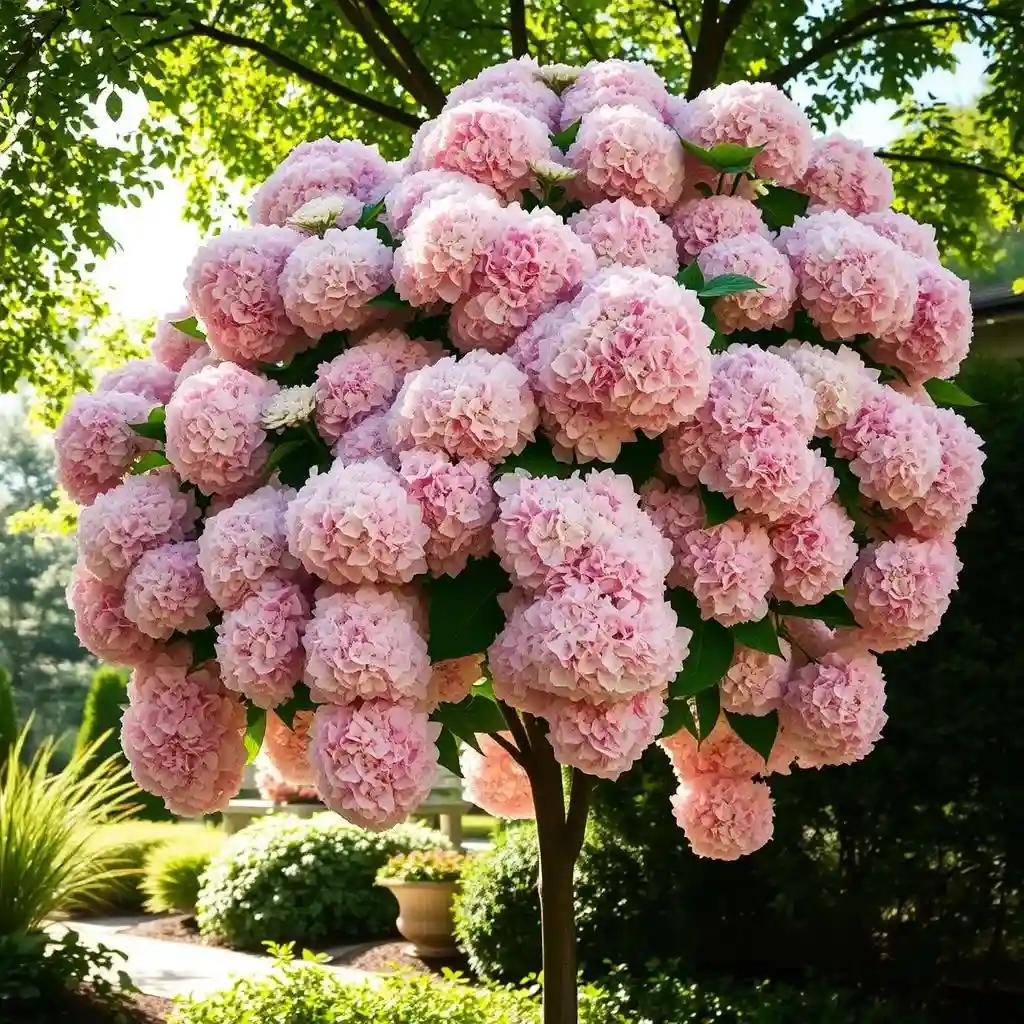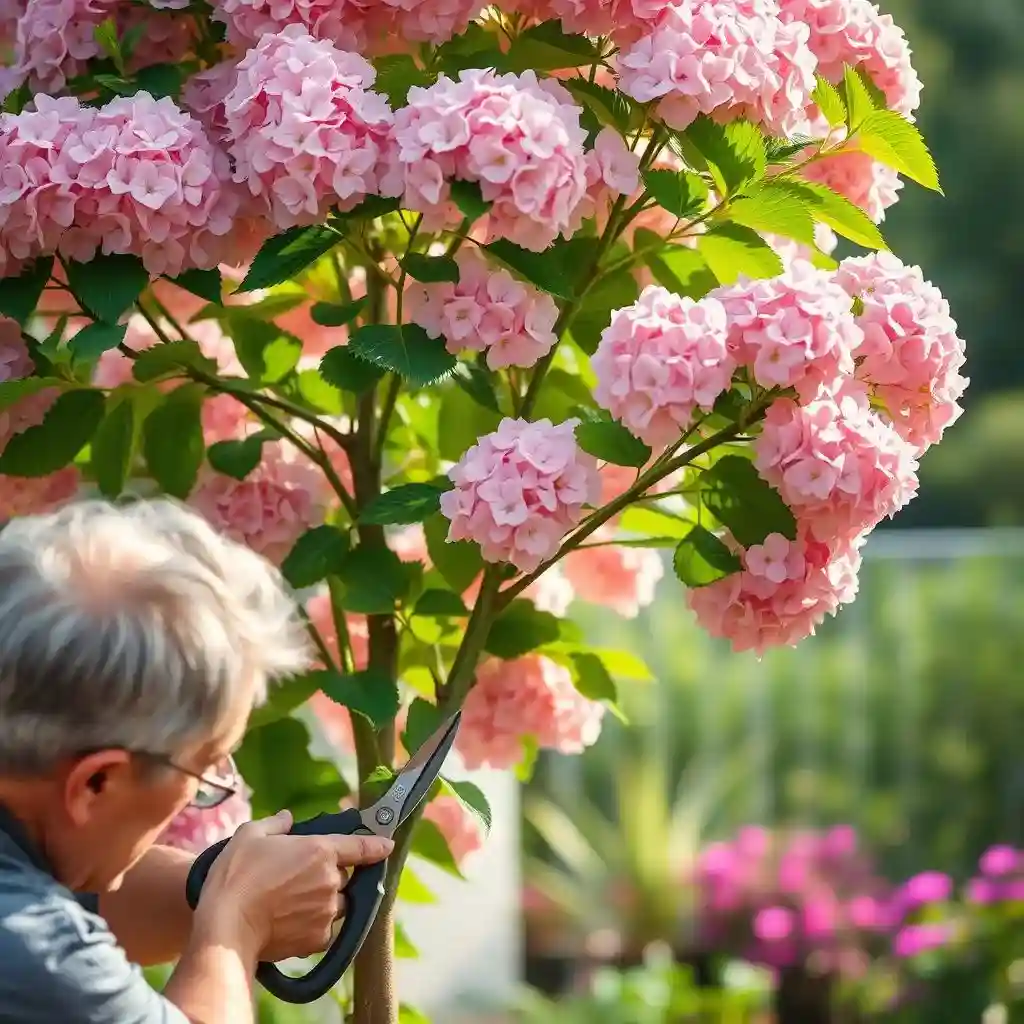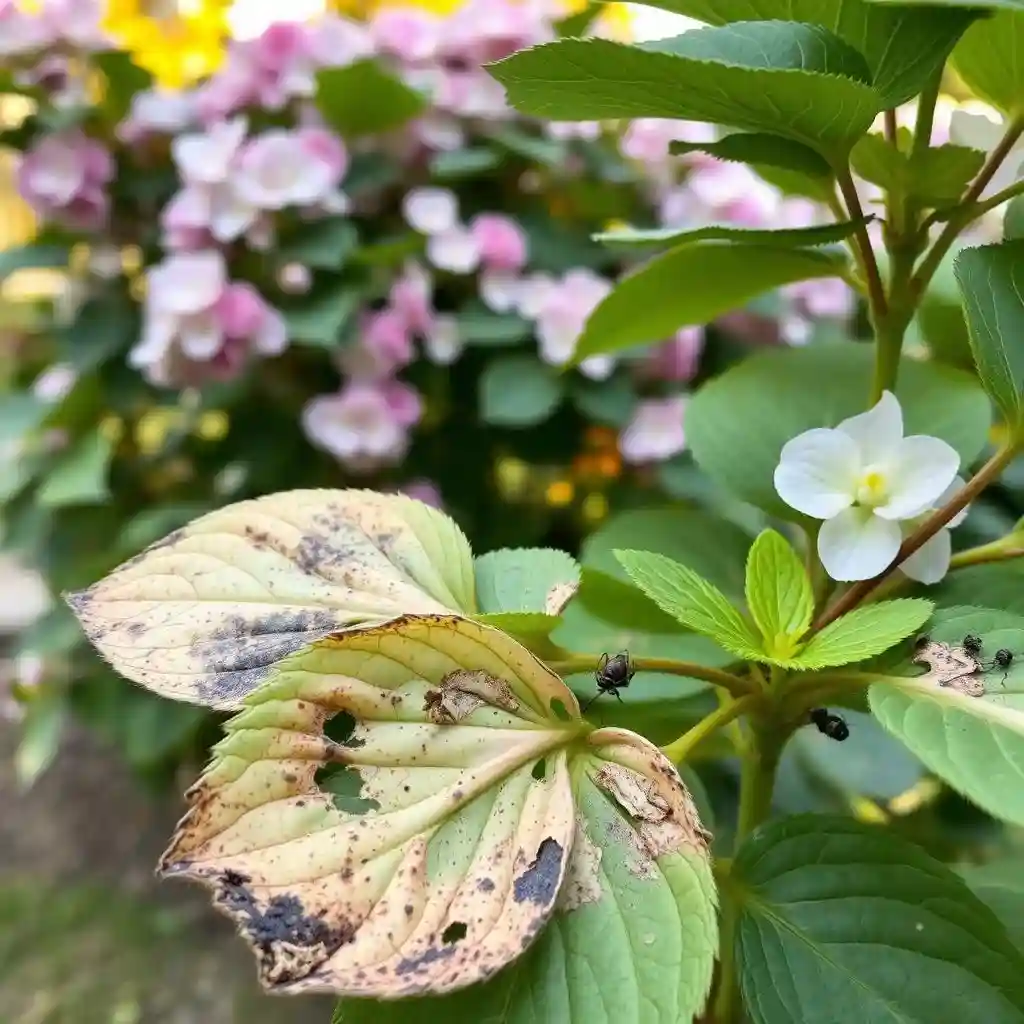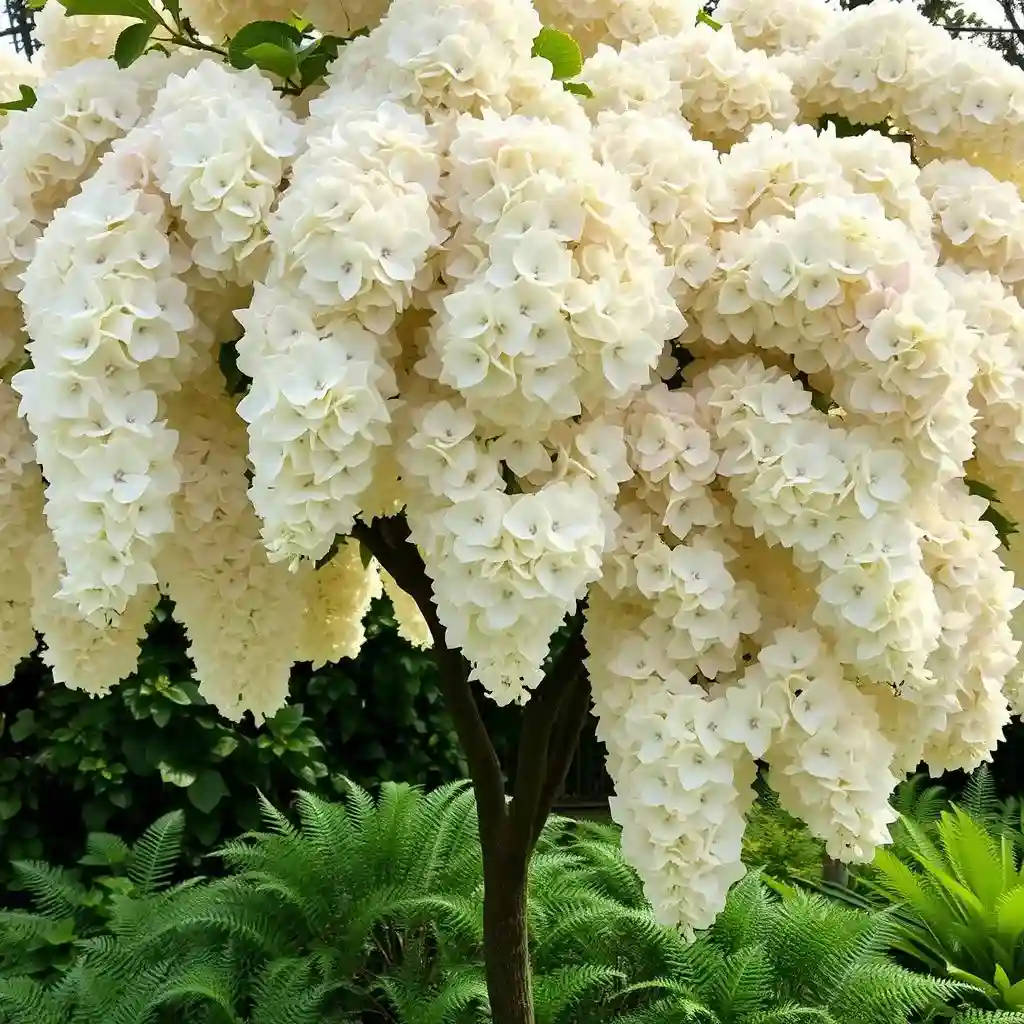Are you looking to add a stunning hydrangea tree to your garden? The Vanilla Strawberry Hydrangea Tree is a beautiful and unique addition to any landscape design.
Key Takeaways
- Learn the unique characteristics of the Vanilla Strawberry Hydrangea Tree
- Understand the essential care requirements for optimal growth
- Discover how to incorporate the tree into your landscape design
- Get tips on maintaining the tree’s beautiful features
- Find out how to overcome common challenges when growing a hydrangea tree
What Is the Vanilla Strawberry Hydrangea Tree?
With its striking blooms, the Vanilla Strawberry Hydrangea Tree has become a favorite among gardeners. This tree is renowned for its vibrant color changes throughout the growing season, making it a captivating addition to any landscape.
The Vanilla Strawberry Hydrangea Tree is a part of the Hydrangeaceae family. It is a deciduous shrub that can be trained into a tree form, known for its large, showy flowers. Originating from hybrid breeding, this variety combines the best traits of its parent plants to offer a robust and visually appealing specimen.
Unique Color Progression
One of the most striking features of the Vanilla Strawberry Hydrangea Tree is its unique color progression. The blooms start as a creamy white, transition to a pinkish hue, and finally mature to a deep strawberry red. This color change adds dynamic interest to the garden throughout the summer months.
Comparison to Limelight and Pinky Winky Varieties
When compared to other popular hydrangea varieties like the Limelight Hydrangea Tree and Pinky Winky Hydrangea Tree, the Vanilla Strawberry Hydrangea Tree stands out due to its distinct color progression. While Limelight is known for its lime-green blooms and Pinky Winky for its pink and white flowers, the Vanilla Strawberry offers a broader range of colors, making it a unique choice for gardeners looking for something different.
Planting Your Vanilla Strawberry Hydrangea Tree

Planting a Vanilla Strawberry Hydrangea Tree requires careful consideration of several factors to ensure its optimal growth and beauty. This process involves understanding the tree’s specific needs, from the ideal location and soil requirements to the best planting times and techniques.
Selecting the Ideal Location and Light Requirements
When selecting a location for your Vanilla Strawberry Hydrangea Tree, consider the amount of sunlight it will receive. This tree thrives in partial shade to full sun, depending on your climate. In warmer climates, it’s beneficial to provide some afternoon shade to prevent scorching.
The Vanilla Strawberry Hydrangea Tree prefers well-draining soil that is rich in organic matter. It can tolerate a range of soil pH, but slightly acidic to neutral soil (pH 6.0-7.0) is ideal. Testing your soil pH and adjusting it if necessary will help ensure the health of your tree.
Best Planting Times and Techniques
The best time to plant a Vanilla Strawberry Hydrangea Tree is in the spring or fall, avoiding the extreme temperatures of summer and winter. When planting, dig a hole twice as wide and just as deep as the root ball. Gently remove the tree from its container, taking care not to disturb the roots, and place it in the hole. Fill with soil, tamping it down gently to remove air pockets, and water thoroughly.
Spacing Guidelines
Proper spacing is crucial for the health and appearance of your Vanilla Strawberry Hydrangea Tree. Plant it at least 3 to 5 feet away from other plants and structures to allow for good air circulation and growth.
Landscape Design Ideas
Incorporating your Vanilla Strawberry Hydrangea Tree into your landscape design can add beauty and elegance. Consider planting it as a focal point, surrounded by complementary plants that share its sunlight and soil preferences. You can also use it as a hedge or screen, taking advantage of its dense foliage.
Essential Care for Vanilla Strawberry Hydrangea Trees

Understanding the care needs of your Vanilla Strawberry Hydrangea Tree is vital for its longevity and beauty. To ensure your tree thrives, you’ll need to focus on several key care aspects.
Seasonal Watering Guidelines
Proper watering is crucial for the health of your Vanilla Strawberry Hydrangea Tree. During the first year after planting, water your tree regularly, especially during hot and dry spells. As the tree matures, it becomes more drought-tolerant, but consistent moisture promotes better blooming. Aim for about 1 inch of water per week, either from rainfall or irrigation.
Fertilization Schedule and Types
Fertilizing your Vanilla Strawberry Hydrangea Tree is essential for promoting healthy growth and abundant blooms. Use a balanced, slow-release fertilizer in early spring, following the manufacturer’s instructions. You can also consider adding organic matter like compost to improve soil fertility and structure.
Key fertilization tips:
- Apply fertilizer in early spring, just as new growth begins.
- Use a balanced fertilizer (e.g., 10-10-10 NPK).
- Avoid over-fertilizing, as this can lead to weak growth.
Pruning Techniques and Timing
Pruning is a critical care aspect for maintaining the shape and promoting the health of your Vanilla Strawberry Hydrangea Tree. Prune your tree in late winter or early spring, removing any dead or damaged branches. To encourage blooming, prune back the tips of the branches, as this variety blooms on new wood.
If you’re growing your Vanilla Strawberry Hydrangea as a tree, regular pruning is necessary to maintain its shape. Remove any suckers or shoots from the base, and trim branches to create a strong, central leader. This will help your tree develop a sturdy structure and enhance its visual appeal.
Winter Protection Strategies
In colder climates, your Vanilla Strawberry Hydrangea Tree may need protection during harsh winters. Apply a layer of mulch around the base to insulate the roots, and consider wrapping the tree with burlap to protect it from wind and extreme cold.
Propagation Methods
You can propagate your Vanilla Strawberry Hydrangea Tree through softwood cuttings taken in early summer. Dip the cut ends in rooting hormone and plant them in a well-draining medium, keeping the soil consistently moist until roots develop.
By following these care guidelines, you can enjoy a thriving Vanilla Strawberry Hydrangea Tree that blooms beautifully for years to come.
Troubleshooting Common Problems

Growing a Vanilla Strawberry Hydrangea Tree can be a rewarding experience, but it’s not without its challenges. As you nurture your tree, you may encounter various issues that can impact its health and beauty.
Pest Identification and Control
One of the common problems you may face is pest infestation. Pests like aphids, spider mites, and scale can weaken your Vanilla Strawberry Hydrangea Tree. To manage these pests, regularly inspect your tree and use organic pest control methods whenever possible.
- Use neem oil to control aphids and spider mites.
- Insecticidal soap can be effective against soft-bodied pests.
- For severe infestations, consider using systemic insecticides.
Diseases such as powdery mildew, leaf spot, and root rot can affect your Vanilla Strawberry Hydrangea Tree. Disease prevention is key to maintaining your tree’s health. Ensure good air circulation around your tree and avoid overhead watering to reduce the risk of disease.
| Disease | Symptoms | Treatment |
| Powdery Mildew | White, powdery spots on leaves | Fungicides, improve air circulation |
| Leaf Spot | Dark spots on leaves | Remove infected leaves, fungicides |
| Root Rot | Wilting, yellowing leaves | Improve drainage, avoid overwatering |
Fixing Color and Blooming Issues
If your Vanilla Strawberry Hydrangea Tree is not blooming as expected or the color is not vibrant, several factors could be at play. Ensure your tree is receiving the right amount of sunlight and that the soil pH is appropriate. Soil conditions can significantly impact blooming and color.
Addressing Growth and Structural Problems
Growth and structural issues, such as uneven growth or weak branches, can be addressed through proper pruning techniques. Regular pruning helps maintain the tree’s shape and promotes healthy growth.
By being aware of these potential issues and knowing how to address them, you can ensure your Vanilla Strawberry Hydrangea Tree continues to thrive and remain a beautiful addition to your garden.
Conclusion
With the right care and attention, your Vanilla Strawberry Hydrangea Tree can become a stunning focal point in your garden. By understanding its unique characteristics, planting it correctly, and providing essential care, you can enjoy its beautiful blooms for years to come.
As you’ve learned from this care and growing guide, the Vanilla Strawberry Hydrangea Tree requires careful consideration of factors like soil quality, pruning, and pest management. By following these guidelines, you can create a thriving environment for your tree to flourish.
As you nurture your Vanilla Strawberry Hydrangea Tree, you’ll appreciate its ever-changing beauty, from the initial white blooms to the deep pink hues that develop over time. With proper care, this tree will continue to be a source of joy and beauty in your outdoor space.

